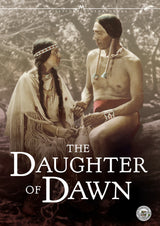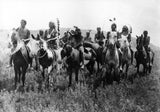Milestone Films
Daughter of Dawn, The
Buy the DVD or Blu-ray

On October 17, 1920, audience members at the College Theater in Los Angeles were treated to a “sneak preview” of a new movie — a drama featuring a cast entirely made up of Native Americans. Motion Picture News called it “an original and breath-taking adventure.” A year later, the film played in Topeka, Kansas to little fanfare — we only know about the engagement because the theater placed a few small ads in a local newspaper. These two showings are the only known screenings of THE DAUGHTER OF DAWN, a large-scale production of Comanche and Kiowa life created by Norbert Myles and the Texas Film Company. After that, the film disappeared for nearly a century—without a trace.
Cinema, the twentieth century’s great art form, proved to be a powerful means for preserving history even as it also perpetuated myths and stereotypes. Although fascinated with images of the “wild west,” very few silent films ever attempted to capture Native American life with the active participation of tribe members. Instead, most films set in the west were centered on white settlers, cowboys and soldiers and Native Americans characters were often played by white actors. But the few films that were created with the cooperation of tribal members, such as In the Land of the Head Hunters [which Milestone will be releasing in a brand-new restoration in 2013] and The Silent Enemy remain invaluable documents of KwaKwaka’wakw and Ojibway life. Alhough created by white filmmakers for general release, these films recorded legends and cultural history as handed down by tribal elders.
But time has not been kind to silent cinema. Only 78% of films made before 1929 still exist and independent films were especially vulnerable to destruction and loss. So it was a lucky day when a private detective who had received some nitrate film reels in exchange for payment contacted Brian Hearn at the Oklahoma City Museum of Art. It turned out that his “fee” was an incredibly rare film, THE DAUGHTER OF DAWN, previously known only through articles and photos from the 1920s and a copy of the script at the Library of Congress. And miraculously, the film was complete and in excellent condition. The Oklahoma Historical Society with assistance of the Smithsonian’s National Museum of the American Indian then acquired the precious film and set out to restore it.
THE DAUGHTER OF DAWN is an 80-minute, feature silent film that was shot in May, June, and July of 1920 in the Wichita Mountains of southwest Oklahoma. The story, played by an all-Native American cast of 300 Kiowas and Comanches, includes a romantic rivalry, buffalo hunts, a battle, village scenes, dances, deceit, courage, hand-to-hand combat, and even a happy ending. The Native American actors, who in 1920 had been living on reservations for less than fifty years, brought with them their own tipis, horses, clothing, and material culture.
White Parker, the film’s male lead, and Wanada Parker, who appears in a supporting role, were two of the 25 children of legendary Comanche chief, Quannah Parker. Chief Parker has recently been profiled in two nonfiction bestsellers, S. C. Gwynne’s Empire of the Sun and Glenn Frankel’s The Searchers. Quannah Parker was a son of chief Peta Nocona and Cynthia Ann Parker, who like the character in the John Ford movie, was kidnapped as a young girl and later married and identified as a Comanche.
The film was directed by a young director, Norbert Myles and written by Richard E. Banks who had spent 25 years living with various tribes. It is fascinating that, by accident or design, the film’s plot hinges on story on a very similar to Quannah Parker’s real encounter with his first wife.
Restored by the Oklahoma Historical Society, Film Technology (35mm) and Modern Videofilm (2K), THE DAUGHTER OF DAWN proves to be a revelation. Subtly acted by the all-Native American cast, photographed beautifully, and directed without melodrama by Myles, this lost silent film stands with the best films of the period. Why it played only twice and was never officially released remains a mystery.
To accompany the restored film, composer David Yeagley wrote an original score that was performed by the Oklahoma City University Orchestra.
Funding for this project provided by: Lawton Community Foundation McMahon Foundation, National Film Preservation Foundation, Oklahoma City University and the Oklahoma Historical Society.
An Explanation of Home, Classroom, and Public Performance Rights
Through our distribution partner, Kino Lorber, Milestone provides a variety of licensing to suit all needs. Our standard institutional licensing packages are designed to provide colleges, universities and qualified non-profits with the best value for multiple uses, and our one-time community screening licenses allow any organization to exhibit high-quality films for a reasonable fee. Please note that all licensing carries restrictions on audience numbers and/or geographic range.
STANDARD INSTITUTIONAL LICENSING
- CLASSROOM RIGHTS allow unlimited use in face-to-face classroom situations for the life of the media, restricted to a single campus or location. Please note that this license doesn't include public screenings or digital transmission of any kind.
- PUBLIC PERFORMANCE RIGHTS (PPR) allow educational and nonprofit groups to exhibit our films to groups of 100 or fewer individuals where admission is not charged. The term of the public performance license is for the life of the DVD. However, if you intend to charge admission, expect an audience over 100, or publicly advertise the screening, then we ask that you contact us regarding an exhibition fee. Films purchased without Public Performance Rights are restricted for individual viewing or face-to-face teaching in the classroom only.
- DIGITAL SITE LICENSES (DSL) allow colleges, universities and nonprofits to locally host and stream to their community on a closed, password-protected system for the life of the digital file.
- K-12 PPR comes with limited performance rights so films can be shown in classrooms, at PTA meetings, during after school programs, and transmitted on a closed-circuit system within a K-12 school building or on a single campus.
For all educational licenses and screenings, please Estelle Grosso, Director of Educational and Non-Theatrical Sales & Distribution at Kino Lorber (Milestone’s distribution partner) at: egrosso@kinolorber.com.
The purchase of DVDs, DVD-Rs, and Blu-rays at the institutional rate by anyone outside of a North American non-profit educational institution does not grant rights for public performance or streaming.
Any continuous or loop screenings as part of a museum exhibition must also be licensed separately. Inquiries must be negotiated directly by emailing egrosso@kinolorber.com.
Information for Exhibitors Screening DCPs and Film Prints
All bookings must be made by email correspondence with George Schmalz, Director of Theatrical Sales at Kino Lorber (Milestone’s distribution partner) at: gschmalz@kinolorber.com to negotiate terms and insure a screening copy is available. An order is only finalized when Kino Lorber sends written confirmation.
DCPs are shipped insured for their cost via Federal Express or UPS and must be returned the same way or by an equivalent method. Shipping and handling charges for outgoing DCPs appear on your invoice. The immediate return or transshipment (as directed) of all DCPs is your responsibility.
DCPs should be returned to:
Milestone Film & Video
38 George Street
Harrington Park, New Jersey 07640-0128
United States
35mm and 16mm prints are shipped insured for their cost via Federal Express or UPS and must be returned the same way or by an equivalent method. Please do not ship prints back via US Mail. Exhibitor pays to ship both ways. Shipping and handling charges for outgoing prints appear on your invoice. The immediate return of all prints is your responsibility.
Prints should be returned insured for $1,000 to:
Iron Mountain
Attn: Milestone Account
235 Main Street
Little Falls, NJ 07424
201.944.3700
For public screenings, advertising materials can be requested by contacting jhertzberg@kinolorber.com.
Milestone is the exclusive licensor for all the titles in this catalog, all of which are available from Milestone’s distribution partner Kino Lorber. in their complete versions.






